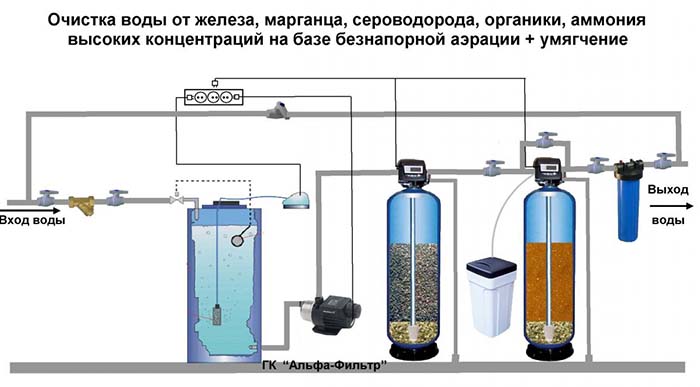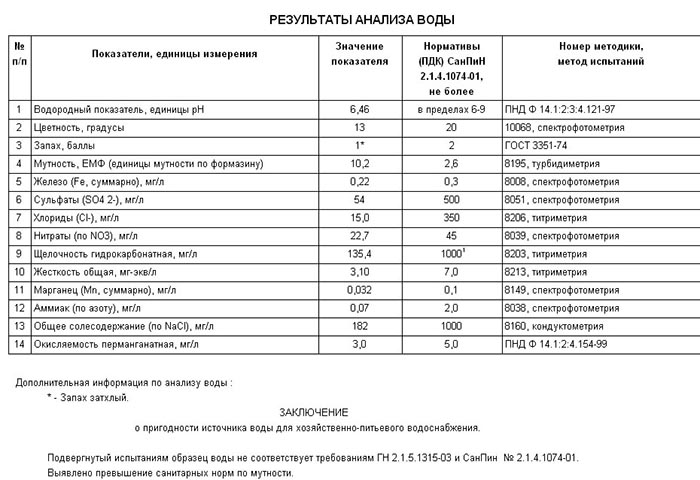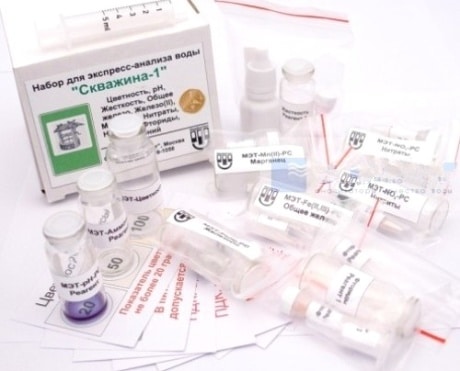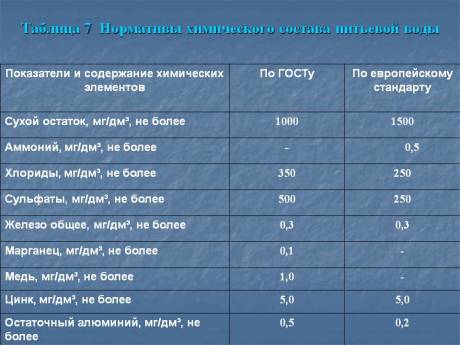Drinking water testing. How to check the quality of water from a well at home
Anyone can join the water quality assessment project. To do this, you need to select a body of water and purchase a test kit.
On the official Monitoring Day website (wwmd.org), a standard test kit costs $ 13 plus shipping. You can also use your own tools. In the future, the indicators are marked on the map.
For those who do not want to join an international project, but want to check the water quality in own home or at the dacha, we will show you how to do it. So, 8 tips for quality control during dy ...
1. Check the organoleptic properties
The first thing to pay attention to is the organoleptic properties of water: color, transparency, smell, taste. The water should be colorless, clear, tasteless and odorless. In addition, it should not leave marks after drying, sediment should not appear in it over time, and the kettle should remain clean after boiling water.
2. Measure pH
Or, in other words, the acidity indicator. If the water contains more hydrogen ions than hydroxide ions, it is considered acidic (pH<7), если наоборот - щелочной (pH>7).
For drinking water pH = 6-9 is considered optimal. To determine pH, you can use special indicator strips (a drop of water is dripped on them, and then the color is compared with a standard), or a pH meter is a device with two electrodes that are immersed in water. The cost of such a device is from 700 rubles.
3. Find out the hardness of the water
This is an indicator of how much calcium and magnesium salts are dissolved in the water. It is useful for a person to drink water of moderate hardness (4-8 mmol / l). Long-term use of hard water increases the risk of kidney stones.
You can check the water hardness either with indicator test strips or with a conductometer (TDS meter).
4. Pay attention to the iron content
Drinking water high in iron is harmful. Yes, it is usually tasteless - such water has a taste and smell of iron and brown sediment. The rate of iron content in drinking water is up to 0.3 mg / l.
You can roughly estimate the iron content in water using color tests. So, a slightly pink solution of potassium permanganate becomes brown in contact with "iron" water. There are also special test kits for the rapid determination of iron in water.
5. Important! Chlorine content
6. Measure nitrates and nitrites
Nitrogen compounds get into water, as a rule, with waste water. Nitrates and nitrites are harmful, their maximum permissible concentration in water is 45 mg / l and 3 mg / l, respectively. You can determine the level of nitrates in water using a nitrate test (indicator strips) or a nitrate meter.
7. Analysis of microbiological contamination
That is, the number of microorganisms in one milliliter of water. Maximum allowable indicator: total microbial count - no more than 50. Exceeding this indicator can lead to disease. It is impossible to measure it at home.
8 What to choose? Self test or laboratory ...
There are household kits for express analysis of water quality for several indicators at once. But if you don't want to mess around with test strips, take the water for analysis at the nearest sanitary-epidemiological laboratory. The cost of such an analysis is 1.5-2 thousand rubles.
And let the monitoring of water quality become a good tradition for your family, because, no matter how trite it may sound, health depends on the quality of water.
A source of water for many summer cottages or in country houses there may be wells or wells. Despite the fact that some out-of-town residents claim that the water in the well is much better and cleaner than the liquid that flows from the tap in cities, one cannot be one hundred percent sure of the quality and safety well water... Many contaminants may not alter the taste, color or odor of the contents of the source. However, contamination with these substances can be hazardous to human health with regular drinking. That is why, after the construction of a new well and periodically during its use, it is worth checking the quality of the well water.
Analysis features
Well water testing is more expensive and time consuming than analyzing the well contents. The thing is that different pollutants can get into the well: components of biological origin, pesticides, surfactants and much more. This is due to the shallow depth of the source. That is why, in order to assess the purity of well water, it is necessary to check it for the presence of the following substances:
- It is necessary to examine the water and determine the concentration of not organic matter, namely lead, mercury, the elements copper and zinc.
- It is imperative to analyze the contents of the well for pesticides.
- The concentration of organic matter is detected.
- An analysis of water for radionuclides is mandatory.
- The concentration of herbicides is calculated.
Attention: at a shallow depth of a well or borehole (no more than 10 m), it is very important to assess the microbiological parameters of the liquid. The thing is that at a shallow depth there are favorable conditions for the reproduction of pathogenic microorganisms.
In addition, the water in the well should be checked for the presence of oil products, surfactants and fertilizers. These substances can freely penetrate into the hydraulic structure during the period of heavy precipitation and during the melting of snow.
Why do we need laboratory water tests?

Well water can be taken to the laboratory for analysis after three weeks of using the new facility. This time will be enough for the pollution that appeared during the construction of the well to settle down by itself and the water is purified. The main purpose of analyzes of drinking water from a mine well or well is as follows:
- Obtain data on the quality of the liquid and its composition.
- Based on the results, it is possible to draw accurate conclusions about the suitability of the contents of a hydraulic structure for drinking and domestic use.
- Based on the analyzes, you can choose the right filtering unit.
In order for the quality of drinking fluid from a mine well or well to comply with the standards, it is very important to choose the right filter. There are many types of filter units on sale today. Moreover, they perform different functions depending on the type of pollutant, and according to the latest data, there are about 130 varieties. To purify water from a well or well, you can use one of the following filters:
- Liquid clarification unit. The main active ingredient in the device is coal. It is suitable for turbid water, with an unpleasant taste and smell of the aquatic environment.
- There are special devices that allow you to purify water from high iron content.
- Filters for softening water are on sale.
- If microbiological contaminants are exceeded, special biofilters are used.
How to test water in a laboratory?

You can analyze drinking water from a well or well in any licensed laboratory, for example, you can contact Rospotrebnadzor. The analysis is done according to the following indicators:
- Calculate the concentration of hydrogen. It should be between 6 and 9 pH. If the values are higher, then you will need to use a filter.
- Determine the overall hardness of the liquid. The fact is that too hard water used in everyday life can cause scale formation in units with heating elements.
- Mineralization of the aquatic environment should not exceed 1 g / l.
- The alkalinity index of the medium is also assessed.
- To determine the oxidizability of water, you need to know the concentration of organic matter.
- Biochemical oxygen index should not exceed 3 mg / l.
- To determine the quality of drinking water, you will need to conduct a toxicological analysis.
How to collect a water sample for analysis?

To pass the liquid for analysis to the laboratory, it is necessary to collect the sample correctly. If this is done with violations, then in aquatic environment other contaminants may be introduced, which will distort the test results. To take water samples from a well or well, it is worth doing the following:
- To do this, you need a container with a volume of 1.5 liters. Better to use glassware or plastic bottle from under the usual unsweetened water. Take bottles of soda, beer, wine, etc. forbidden. The thing is that indelible elements remain on the walls of the container, which can affect the results of the analyzes.
- If you will be drawing water not from the well itself, but from the pipeline coming from the source, then let the water drain for 15 minutes. During this time, the liquid stagnant in the pipes will escape, and you will collect water from the source.
- Be sure to rinse the water collection container well. Just do not use various detergents... It is best to rinse the bottle several times with spring water.
- If you are drawing water from the tap, then the pressure should not be strong, since then a lot of oxygen will get into the water. This can lead to chemical reactions in a container and inaccurate test results. For the same reason, it is recommended to let the jet flow gently inward along the bottle wall.
- The container should be filled with water to the top and tighten the lid tightly. It is important that no air remains in the container, and also does not get inside from the outside.
- The container indicates the date, time, place of sampling, as well as the type of source.
- The bottle should be wrapped in a dark bag to protect it from exposure to sunlight, which can cause the growth of organic matter.
- Samples must be delivered to the laboratory within 3 hours after collection. If it is not possible to immediately take the container, then the samples can be stored in the refrigerator for two days.
Attention: containers with samples must not be frozen in the freezer.
Compliance with the rules for collecting samples will allow an accurate analysis of the contents of the water intake. This will help in the future to choose the right filtration equipment. However, do not think that the quality of drinking well water is a constant indicator. It can be influenced by various factors, so the tests should be repeated regularly.
Inspection frequency

Since the water in the well can change its composition under the influence of various factors, it is worthwhile to regularly analyze its composition in the laboratory. This is especially important if you are using water for drinking.
As a rule, such inspections are carried out every two years for sources that are used regularly (year-round) and once a year for wells with seasonal use, for example, in the country this structure can only be used in warm time of the year. This regularity of checks is due to the fact that water can stagnate in the source of seasonal use, which leads to silting, bacterial growth and deterioration of the quality of the liquid.
It is important to know: if a road was recently built near your well, there are landfills, industrial enterprises or farms, the frequency of inspections will be much higher. This is due to the fact that the presence of potential contaminants nearby can negatively affect the composition groundwater that easily penetrate wells.
Self-analysis of water
If you do not have time to take fluid samples to a laboratory or there is no such institution nearby, then you can do a water analysis yourself. However, it can only be used as a temporary measure and you should not rely entirely on the results obtained. Better to get to the laboratory later.
Conclusions about water quality are made on the basis of such observations:
- The muddy contents in the well may be due to the ingress of particles of sand and clay into it. In this case, you will need to arrange a new bottom filter, since the old one does not cope with its tasks. Also, the cause of cloudy water can be depressurization of the seams. Through them, dirty groundwater enters the structure.
- The rusty color of the water and the taste of iron indicate an excess of this element in the composition of the water. Use a special filter to deal with the problem.
- The rotten smell of the contents of a hydraulic structure indicates an increased content of hydrogen sulfide in it. This substance appears as a result of the vital activity of bacteria and decomposition organic compounds... Usually, active reproduction of bacteria is associated with stagnation of water and siltation of the source. The well needs to be cleaned and used regularly.
- The smell of petroleum products indicates ingestion Wastewater into the well. You cannot drink from such a source.
As you know, there is no life without water. But drinking water is not the notorious H2O from the school chemistry course. Even distilled water, in addition to the hydrogen-oxygen compound, contains impurities. What can we say about tap water, and even more so about ground water. The question of whether or not to drink dubious liquid from wells and wells is easy to solve. A water sample (~ 1-1.5 l) is submitted for analysis to a certified laboratory and an official document with the main quality indicators is received. What if there is no such laboratory nearby? Then it remains to independently conduct a water analysis at home.
The quality of drinking water is regulated by GOST and SanPiN 2.1.4.1074-01. They indicate the requirements for organoleptic properties in terms of:
- smell,
- smack,
- chromaticity,
- turbidity.
Organoleptic analysis of water at home is an express diagnostics, for which reagents and devices are not required. The water is simply poured into a glass container and its smell / taste is determined. It is optimal if the liquid does not smell or taste (0–1 points). Light odor / taste is allowed (2 points). According to GOST, the score is 3 points and above (the water clearly smells) - the liquid is not suitable for internal use.
Please note: if there is a pronounced odor, the water should not be drunk.
Organoleptic standards are regulated by SanPiN 2.1.4.1074-01
Color is due to the content in the water of colored organic substances present in humus; metals; industrial effluents. According to SanPiN 2.1.4.1074-01, chromaticity is not more than 20 degrees. In laboratories, the indicator is determined visually using reagents and a special scale, and / or photometrically. At home, you can assess the color only "by eye" by placing it behind a glass container with water White list... Light coloring is only permissible for groundwater.
The transparency of the water is determined visually. When viewed by light, the liquid is absolutely transparent, which means that the water can be drunk. Incomplete transparency groundwater due to the presence of iron hydroxide. This water can be drunk after settling. A grayish tint indicates an excess of manganese.
Please note: prolonged use of water with an excess of iron hydroxide is fraught with the development of degenerative processes in the organs.
How to do a water analysis at home
Test kits can be purchased from companies that sell water filters and pet stores that have supplies for aquarists. For a "home laboratory" you need:
- The standard set for determining the pH (acidity) - pH.
- General hardness test - Gh.
- A kit that helps to establish the content of Fe2 +.
- Test for the determination of Fe3 + ions.
- Tests for nitrates, nitrites, manganese, ammonium, sulfides, fluorides.
They produce universal kits for water analysis: "Rodnik", "Well", "Well", "Professional".

The cost of test kits is from 275 to 1500 rubles

Imported express test kits provide more accurate results
Methodology
The pH measurement method depends on the kit used.
Option number 1: the litmus strip is moistened with water and the color is compared with the color scale on the package.
Option number 2: the amount of water required according to the instructions is added to the bottle with the reagent, shaken. The test strip is moistened with the resulting solution and the color is compared with the supplied scale. The pH norm is in accordance with GOST 6.5-9.

It is not difficult to determine the pH of the liquid: the wetted strip is aligned with the identical color on the scale and the corresponding value is observed.
Determination of the total hardness: the volume of water required according to the instructions is measured into a special container. Then add the reagent dropwise and shake the bottle. When the liquid changes color and turns olive green, the analysis is complete. The number of drops corresponds to the degree of hardness. According to GOST, a stiffness of up to 7 is permissible (in exceptional cases - up to 10).
Fe2 + and Fe3 + identification method. Add the required volume of water and the supplied reagents to the bottle from the kit. According to the intensity of the color change, the amount of ferrous iron is estimated. The analysis for ferric iron is carried out in a similar way. Tests are available to determine the amount of total iron.

Indicators chemical composition water from wells / wells usually exceeds the norm for the content of iron, manganese, calcium
It's nice to feel like an analytical chemist and check the quality of water without leaving your home. But it is still better and more reliable to order an analysis in a laboratory. A professional opinion is a detailed table of the main indicators of drinking water. Home testing is very rough.
Video: how to check water quality yourself


